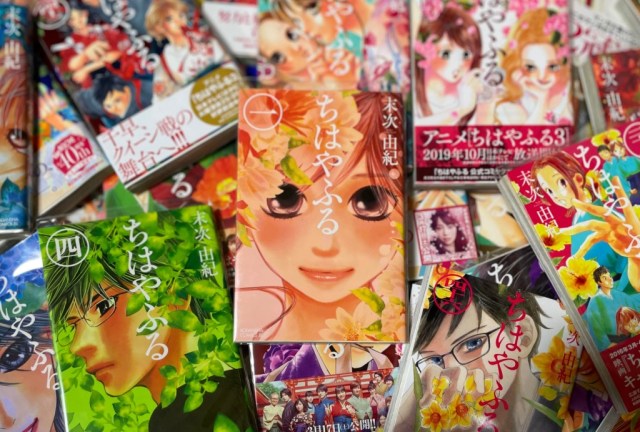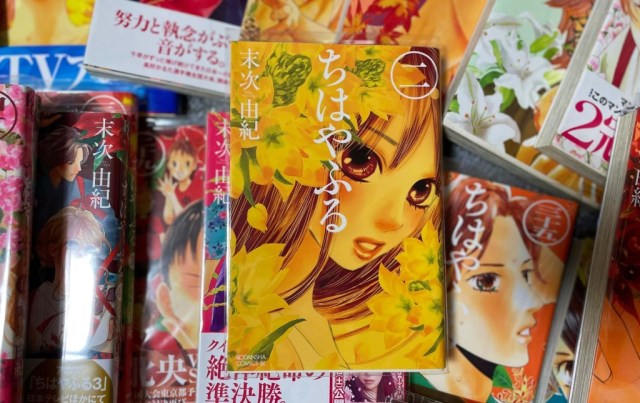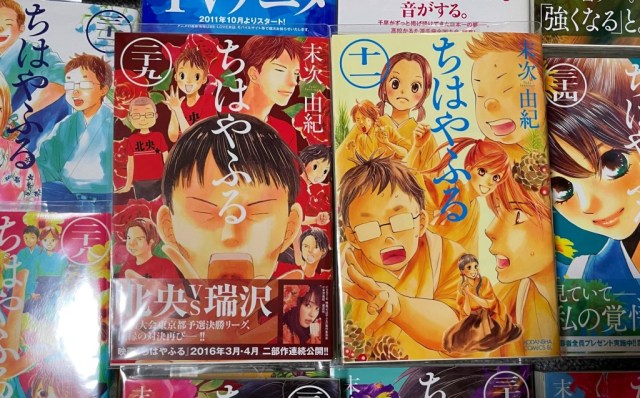
She’s not the only one whose life has been impacted by the emotional weight of this story.
Yuki Suetsugu’s manga Chihayafuru has been serialized in Kodansha’s Be Love magazine since December 2007. The story center on competitive karuta playing, a game in which players try to grab cards printed with verses from classical Japanese tanka poems. Since its debut, it’s inspired a long anime series, a trio of live-action movies (with a really catchy theme song), and a whole generation of Japanese youth to pick up a game that was previously thought of as an old-fashioned activity to play only on New Year’s.
It was recently announced that the collected Volume 49 of Chihayafuru will be its final volume. Our Japanese-language correspondent K. Masami has been a fan of the manga since its debut. She wanted to share some of her reflections on the series now that it’s nearing its end and she’s left awash in a wave of nostalgia. Take it away, Masami.
▼ An illustration by Yuki Suetsugu announcing the release of Volume 48 of the manga on February 10
#ちはやふる48巻 pic.twitter.com/jmmBRso7TL
— 末次由紀 2/10ちはやふる48巻発売 (@yuyu2000_0908) February 9, 2022
I forget to breathe. It’s always like that when I’m reading Chihayafuru. The moment I open the first page, it’s like my entire spirit is sucked in. I’m mentally and physically exhausted at the end.
Yet, I always look forward to the next chapter. I want to live the kind of life where I can always challenge myself and stand alongside the characters in whatever trials they’re currently facing.
However, whenever a story begins, it must eventually end. This story that I’ve followed for so long is now nearing that time. Please allow me to use this space to write a bit about the appeal of the series from my perspective.
The theme of Chihayafuru, which inspired an anime series and live-action films, is competitive karuta. It’s a manga where boys and girls passionately play karuta over and over again.
I was a university student studying Japanese literature at the time it began serialization in 2007 in Kodansha’s Be Love magazine. I remember how some of the students were saying, “I hear there’s a new manga about karuta. Who would read that?!” While the classical Japanese anthology of one hundred waka poems (Ogura Hyakunin Isshu, which serves as the basis for a standard deck of karuta), is fairly well-known these days, 15 years ago that was not the case. Even within the Japanese Literature Department, only one or two students picked it as a topic for their graduation theses each year.
However, just in this span of time, the game has become so popular! My high school-teacher friend said that competitive karuta is apparently now even a common after-school club activity at many schools. It’s not an exaggeration to say that this is due to the influence of Chihayafuru.
The story holds the same kind of meaning to humanities-focused people like me as Captain Tsubasa does to sports fans. From the first time you read it to the last time, it will make you want to become involved in karuta in some way or another. It’s just that powerful.
To give those of you who are still debating whether to read it or not a friendly little push, I’ve tried to sum up just a few of its major merits below.
▼ Masami’s copy of Volume 44 of the manga in a post from 2020 detailing “the best manga to take your breath away”
1. You can grow alongside the characters
Each of the characters in Chihayafuru has their own individual story about why they’re passionate about karuta, why they continue to play, and their goals for the future. They keep on playing, sometimes by themselves and sometimes as part of a team, all while embracing their unique motivations. They don’t just play simply because it’s fun.
The struggle of not improving, the frustration of not doing as well as someone who began playing after you, jealousy, resignation…all of these emotions are mixed in together. As a result, you end up empathizing with each character and feel emotionally drained after reading. On top of that, karuta is a game where when there’s a winner, there’s got to be a loser.
It’s a world where even the strongest players aren’t undefeated. In other words, the true challenge starts when they lose. However, they always have to decide where to go from there and they won’t give up thinking about what else they can do to get better. The reader can also gain encouragement from their battles at the same time.
I personally love the words of Mr. Hideo Harada, the teacher who mentors protagonist Chihaya Ayase and others in the Shiranami Karuta Society, to her childhood friend Taichi Mashima in the second manga volume:
“‘You can’t get stronger even after practicing all of your youth?’ Please say that once you’ve tried.”
I’ve read that quote so many times. I’ve been comforted by Mr. Harada’s words in real life when I want to give up, or things don’t go my way. It definitely feels like I’ve matured alongside the characters.

2. Grabbing the karuta is dynamic and beautiful
After my heart was pulled in, so were my eyes. Chihayafuru is visually stunning. The characters’ postures and movements while grabbing the cards are breathtakingly beautiful, dignified, and agile.
When I’m watching a game of competitive karuta in real life, I have trouble following the quick movements (I have low vision as well). Seeing the movements framed in static panels gives me a much better sense of what’s actually happening. My knowledge of this world I wanted to know more about started expanding from there. It makes me admire the striking visual lines all over again.
It also makes me wonder how much the manga artist, Yuki Suetsugu, observed karuta games as part of her research for the series. I’m impressed by how well she can convey the charm of karuta in an instant through her drawings when words won’t do it justice.

3. It’s available to read for free on many different apps
I could keep going on and on about how wonderful Chihayafuru is. I could talk at length about the poems that appear in each chapter, or so many other topics. Even if you don’t have any current interest in the game of karuta, you’ll be wanting to learn more after reading just one volume of the manga.
This may be limited to readers in Japan, but Volume 47 was available for free on the Magazine Pocket app over a limited two days recently. It’s also available for free on the Palcy app to read in its entirety until March 9. The story is so good that I hope many other manga-reading apps will continue to offer it well into the future.
I’m having a really hard time accepting that Volume 49 will be its last one. Chihayafuru has been a part of my life for almost 15 years now, so it feels like I’m losing a friend. But I’ll do my best to take part in the wave of celebrations now popping up to celebrate its long run. I’ll also use this as a chance to reread the story from Chapter 1. I hope that my words will inspire even just one person to pick up this wonderful story.
For another centuries-old game that was popularized in the past two decades by a manga/anime series, please check out “Go.”
Reference: Be Love, Palcy
All images © SoraNews24
● Want to hear about SoraNews24’s latest articles as soon as they’re published? Follow us on Facebook and Twitter!

No hay comentarios:
Publicar un comentario